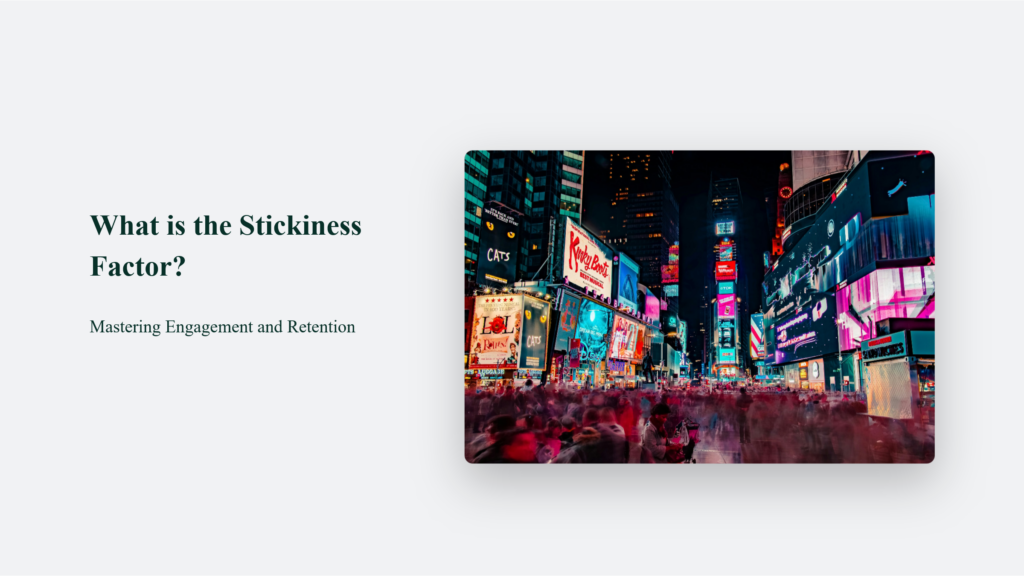In today’s digital era, where the competition for attention spans feels more like a high-stakes game, the “Stickiness Factor” concept emerges as a beacon for content creators and marketers alike. This enigmatic quality, which makes an idea, product, or message memorable and compels the audience to return for more, is not just a matter of luck but a crafted element of success. So, let’s dive deep and find out what is the stickiness factor?

What is the Stickiness Factor?
At its core, the Stickiness Factor refers to the intrinsic attributes of a message or concept that make it unforgettable and impactful. It’s about creating content that resonates so deeply with the audience that it becomes a part of their cognitive landscape, influencing their decisions and behaviours. Malcolm Gladwell popularized this phenomenon in his book “The Tipping Point,” highlighting how certain messages “stick” in the public’s mind and lead to widespread adoption or change.
Making It Stick: A Blend of Science and Art
Creating sticky content that captures and sustains attention is a sophisticated blend of science and art, a strategy that marries psychology with creativity and a deep audience understanding. “Sesame Street” and “Blue’s Clues” exemplify this approach through innovative educational content that engages young minds.
“Sesame Street”: Pioneering Educational Television
“Sesame Street” broke new ground in children’s programming by using extensive research to craft educational content that was both engaging and informative. The creators focused on making literacy and numeracy fun and accessible, using a combination of live-action, puppetry, and animation. This approach was based on the premise that if you can maintain a child’s attention, you can teach them complex concepts. Through careful observation and testing, the producers discovered that children are more engaged when they understand the content, leading to higher retention rates. The introduction of characters that interacted with the children in the show and the audience at home was a game-changer, making learning feel more personal and impactful.
“Blue’s Clues”: Reinventing the Formula
Nearly three decades later, “Blue’s Clues” took the blueprint created by “Sesame Street” and evolved it further. The creators of “Blue’s Clues” designed the show to be more than just passively educational; they wanted to create an interactive experience. The show used a narrative structure, with each episode focusing on solving a puzzle with the audience’s help at home. This format encouraged active participation, which research has shown to improve retention and understanding. The simplicity and repetition within the show, coupled with direct engagement with the viewers, made the content stickier, ensuring that the educational messages were received, remembered, and understood.
The Science Behind Stickiness
The success of both shows can be attributed to their application of psychological principles in their content creation. It includes understanding the developmental stages of their audience and crafting developmentally appropriate and engaging messages. For example, repetition, direct address, and interactive elements in “Blue’s Clues” leverage how young children learn and process information. Meanwhile, “Sesame Street” integrates diverse educational content with entertainment, holding the viewer’s attention while subtly teaching them.
Both shows demonstrate that the stickiness factor in educational content goes beyond just capturing attention; it’s about creating a learning experience that resonates deeper. By making the content relatable and interactive, they ensure that the information is consumed and integrated into the child’s knowledge base.
The Art of Engagement
At the heart of creating sticky content is the art of engagement. It involves storytelling, character development, and using visuals and music to create an immersive learning environment. Both “Sesame Street” and “Blue’s Clues” excel in this, using characters and narratives children can relate to and become invested in. Music and catchy songs enhance retention, as melodies and rhythms are easier to remember than spoken words alone.
The Practical Path to Stickiness:
Incorporate a Personal and Practical Touch
- Example: Howard Leventhal’s study at Yale showed that simply providing practical, actionable information significantly boosted responsiveness to health advisories. This principle is broadly applicable and demonstrates that practicality enhances memorability.
- Tip: Always aim to connect your message or product features with real-life applications or solutions to common problems. It’s not just about informing; it’s about solving.
Embrace Counterintuitive Approaches
- Example: “Sesame Street” challenged the notion that television was ineffective for educating children. Its unconventional combination of entertainment and education made it a groundbreaking success.
- Tip: Don’t be afraid to question and overturn established norms within your industry. Sometimes, the most impactful ideas come from challenging the status quo and presenting your audience with something unexpected.
Engage with Emotion
- Example: Emotionally charged messages, whether through compelling storytelling, impactful visuals, or evocative music, are more likely to be remembered. This approach turns a simple message into an unforgettable experience.
- Tip: Dive deep into the emotional core of your message. Consider the feelings you want to evoke in your audience and how you can authentically connect emotionally. Tapping into these emotions can make your content stick, Whether joy, curiosity, empathy, or excitement.
By focusing on these three key areas, you can significantly enhance the stickiness of your content or product, ensuring it captures and maintains your target audience’s attention and loyalty. Remember, the goal is to leave a lasting impression, encouraging continuous engagement and advocacy.
The Bridge to Customer Stickiness
In the realm of marketing, the Stickiness Factor transcends memorable content to encapsulate the essence of customer loyalty. Customer stickiness refers to the likelihood of repeat business, driven by the customer’s perception of value, quality, and satisfaction. Brands that master the art of making their products indispensable enjoy the benefits of long-term customer relationships and, ultimately, sustained profitability.
The Bottom Line:
By infusing your strategies with the essence of the Stickiness Factor, you’re not just reaching out to your audience; you’re creating lasting connections that inspire action, loyalty, and growth.\
Frequently Asked Questions:
How can I measure the Stickiness Factor of my content or product?
Engagement metrics, customer feedback, and repeat purchase rates are key indicators of stickiness. High engagement and positive feedback suggest your content is resonating, while repeat purchases signal product stickiness.
Can the Stickiness Factor be applied to any industry?
Absolutely. Creating sticky content or products can significantly enhance your impact and success if you’re in education, retail, tech, or any other sector.
Is the Stickiness Factor more about content or delivery?
It’s a combination of both. Great content needs to be matched with effective delivery methods that suit your audience’s preferences and habits.




